Yojana Summary: June 2024 – Forts of India
1. Role of Forts in Indian History
- 1. Role of Forts in Indian History
- 2. Defence architecture of forts of Andhra Pradesh & Telangana
- 3. Golconda Fort – The Impenetrable Fortress
- 4. Forts of Gujarat: Guardians Of Legacy and Lore
- 5. Forts In Delhi
- 6. Bekal Fort: A Fusion of culture and History echoing through time
- 7. Vellore Fort: The Great Garrison of South India
- 8. Medieval Ports and Forts
- 9. India on the UNESCO World Heritage List
Introduction
- The term ‘fort’ typically refers to a strong protective structure or place, often enclosed by a wall, wooden palisade, or fence, and further protected by moats, ditches, or multiple fortified walls.
- These structures were guarded by warriors and strategically located to enhance the defensive features of a town, city, or kingdom capital.
- Over centuries, India has seen the rise of numerous forts, from full-fledged complexes to minor defensive posts, scattered across its landscape.
Early Fortifications
Prehistoric and Proto-Historic Era
- Fortifications date back to prehistoric times when natural and artificial means were used for protection.
- The Harappan civilization (c. 3000-1500 BCE) provides the earliest archaeological evidence of fortified cities like Dholavira and Harappa, with impressive walls and citadels.
Historic Period
- By the 4th century BCE, fortified cities such as Pataliputra, Kosambi, Ujjain, and Takshashila emerged.
- These cities often had ramparts, gates, and bastions for protection.
Fort Architecture and Evolution
Material and Methods
- Early forts used earthen ramparts, rubble and earth, and later, stone and masonry.
- Hill passes were fortified using local rocks, as seen in Rajgriha.
Design and Layout
- Forts varied in design, influenced by regional styles and the ruling dynasties.
- They included features like citadels, defensive walls, bastions, and moats.
- The introduction of artillery in the 16th century led to thicker walls and extended bastions.
Types of Forts
Kautilya’s Classification
- In the Arthashastra, Kautilya categorises forts into six types based on their major modes of defence:
- Jal-Durga (Water Fort)
- Dhanvana or Maru-Durga (Desert Fort)
- Giri-Durga (Hill Fort)
- Vana-Durga (Forest Fort)
- Mahi-Durga (Earthen Fort)
- Nri-Durga (Human Fort)
Examples
- Notable examples include the hill forts of Chittorgarh and Gwalior, the desert fort of Jaisalmer, and the water fort of Murud-Janjira.
Forts through Dynasties
Rajput Forts
- Examples include Chittorgarh, Kumbhalgarh, and Jaisalmer, characterised by their massive stone walls and strategic locations.
Sultanate and Mughal Forts
- Forts like Agra Fort and Delhi’s Red Fort represent Mughal architectural grandeur with their extensive use of red sandstone and intricate designs.
Maratha and Sikh Forts
- Maratha forts like Raigad and Rajgad, and Sikh forts like Qila Mubarak in Patiala, illustrate regional defensive strategies and architectural styles.
Colonial Forts
- European powers built forts such as Fort St. George in Chennai and Fort William in Kolkata, incorporating European defensive techniques.
Significance
Strategic Importance
- Forts were crucial for the defence of kingdoms, protecting against invasions and serving as military strongholds.
Political and Administrative Centres
- Many forts served as administrative hubs and royal residences, symbolising the power and authority of rulers.
Cultural and Architectural Heritage
- Forts are a testament to India’s rich cultural and architectural heritage, reflecting the diverse influences and engineering prowess of different periods.
Economic and Trade Control
- Strategically located forts controlled trade routes and economic resources, enhancing the wealth and stability of kingdoms.
Conclusion
- Forts played a vital role in the history of India, serving as military bastions, administrative centres, and symbols of power.
- Their architectural diversity and strategic importance highlight the ingenuity and resilience of ancient Indian societies.
- Today, these forts stand as monumental heritage sites, offering insights into India’s rich historical legacy and contributing to its cultural tourism.
2. Defence architecture of forts of Andhra Pradesh & Telangana
Introduction
- The forts in Andhra Pradesh and Telangana stand as remnants of ancient architectural marvels, reflecting the region’s historical significance and defensive strategies.
Early History and Evolution
- Forts and fortified towns date back to the accounts of Megasthenes and Pliny, indicating their strategic importance in ancient times.
- Initially constructed with mud and brick, these forts evolved into formidable stone structures during medieval periods.
Significance of Forts
- Centres of Power and Governance: These forts served as administrative centres, protecting rulers and their subjects.
- Cultural and Historical Significance: They are repositories of architectural and cultural heritage, providing insights into past societies.
Key Forts in Andhra Pradesh
- Kondapalli Fort: Located in the NTR district, it exemplifies Indo-Saracenic architecture and witnessed rule under various dynasties including the Qutb Shahis.
- Kondaveedu and Addanki Forts: Initially Reddy kingdom strongholds, these forts saw conflicts involving Gajapatis, Vijayanagara, and later, the Qutb Shahis.
- Udayagiri Fort: Strategically situated in PSR Nellore district, it was pivotal during Vijayanagara rule and later annexed by the Qutb Shahis.
- Gooty Fort: An extensive fortification in the Anantapuramu district with layered defences, symbolizing resistance against various invaders including the Marathas and Mughals.
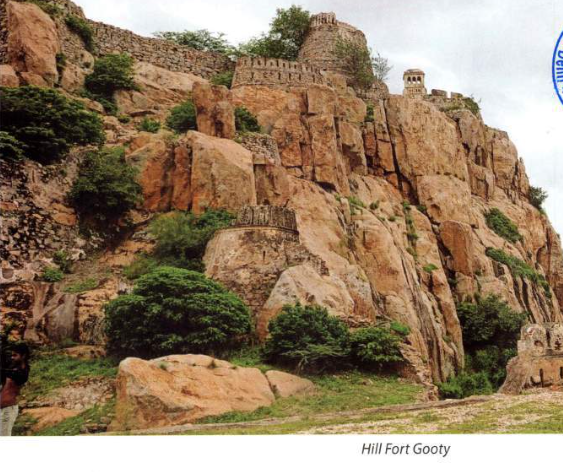
- Penugonda Fort: Once the capital of the IV dynasty of Vijayanagara kings, it faced multiple attacks from Adil Shahi and Qutb Shahi forces.
Key Forts in Telangana
- Warangal Fort: Known for its Kakatiya legacy, it features concentric fortifications and impressive stone architecture, showcasing advanced medieval fortification techniques.

- Bhongir Fort: A prominent hill fort, it served as a strategic stronghold during the Kakatiya and later Qutb Shahi periods, known for its steep slopes and unique architecture.
- Golconda Fort: Famous for its impregnable structure and diamond mines, it played a crucial role under the Qutb Shahi dynasty and later came under the control of the Nizams.
Issues
- Preservation Challenges: Many forts face deterioration due to neglect and lack of conservation efforts.
- Urban Encroachment: Surrounding urbanisation threatens the integrity of these historical sites.
Solutions
- Conservation Initiatives: Government and community-driven efforts to restore and maintain these forts.
- Awareness and Tourism: Promoting these sites as tourist attractions to generate interest and funding for conservation.
Conclusion
- The forts of Andhra Pradesh and Telangana not only symbolize architectural prowess but also serve as cultural landmarks that connect the present with the rich historical past. Efforts towards their preservation are essential to safeguarding their heritage for future generations.
3. Golconda Fort – The Impenetrable Fortress
Introduction
- Golconda Fort, derived from the Telugu word ‘Golla Konda’ meaning shepherd’s hill, is a historic fortress located in Hyderabad, Telangana.
- The fort has played a significant role in the history of the Deccan region.
History
- Originally ruled by the Kakatiyas, Golconda was fortified and expanded under the Bahmani Sultanate from 1363 AD onwards.
- Sultan Quli Qutb-ul-Mulk founded the Qutb Shahi dynasty in 1518 AD and established Golconda as the capital.
- The Qutb Shahi rulers were patrons of Deccani and Telugu literature, contributing significantly to the cultural landscape of the region.
Architecture
- Golconda Fort features a robust three-tiered fortification with a moat and eight entrance gates, including Fateh Darwaza, Moti Darwaza, and others.
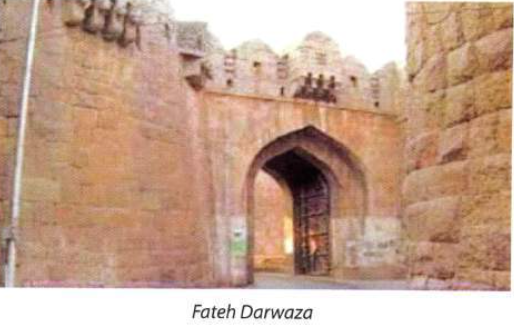
- The fort includes mosques like Jama-e-Masjid and Taramati Mosque, palaces, audience halls (Diwan-e-Aam, Diwan-e-Khas), and functional buildings like the Aslah Khana (Armoury).
- Jama-e-Masjid, founded by Sultan Quli Qutb Shah I, is a notable architectural piece inside the fort.
- Taramati Mosque is known for its elegant design with three arches and minarets, reflecting the artistic prowess of the Qutb Shahi period.
- Baradari (Darbar Hall) is a double-story building serving as the General Assembly, offering panoramic views from its high elevation.
- Aslah Khana (Armoury) is a three-story structure once used to store weapons, displaying intricate architectural details.



Water Management
- Durg Tank, a reservoir that supplied water to the fort and its gardens, showcases advanced hydraulic engineering for the time.
- Various cisterns distributed water throughout the fort, ensuring a steady supply for domestic and military needs.
Issues
- Golconda Fort faces challenges in preservation due to its age and exposure to natural elements.
- Managing tourism while preserving historical integrity is a continuous challenge.
Significance
- Golconda Fort stands as a testament to the rich cultural and architectural heritage of the Qutb Shahi dynasty.
- The fort attracts tourists and historians alike, offering insights into mediaeval Indian fortification and lifestyle.
Conclusion
- Golconda Fort remains a symbol of Hyderabad’s historical legacy, blending military architecture with cultural richness.
- Its enduring structures and historical significance continue to inspire admiration and study.
4. Forts of Gujarat: Guardians Of Legacy and Lore
Introduction
- The forts of Gujarat stand as guardians of the state’s rich legacy and lore, reflecting its historical significance and strategic importance.
- These forts have witnessed various dynasties and empires, serving as both defensive strongholds and centres of administration.
Historical Background
- Gujarat’s forts date dates back to ancient times, with several mentioned in historical texts and records.
- They have been under the rule of different dynasties, including the Mauryas, Chalukyas, Solankis, and the Mughal Empire.
- These forts evolved in architectural style and strategic importance over centuries, adapting to changing political and military landscapes.
Key Forts in Gujarat
- Junagadh Fort: Also known as Uparkot, this fort is one of the oldest in Gujarat, with origins tracing back to the Mauryan Empire. It features Buddhist caves, step wells, and fortifications that highlight its historical significance.

- Pavagadh Fort: Located in the Panchmahal district, Pavagadh Fort is known for its religious importance and historical value. It was a stronghold of the Rajput and later the Sultanate of Gujarat.

- Champaner Fort: Situated near Pavagadh, Champaner Fort is part of the Champaner-Pavagadh Archaeological Park, a UNESCO World Heritage Site. It showcases Indo-Islamic architecture and has significant historical monuments, including mosques and palaces.
- Bhujiya Fort: In Bhuj, this fort served as a defence against invasions and is known for its strategic location on a hill. It played a crucial role during the times of the Jadeja Rajputs.
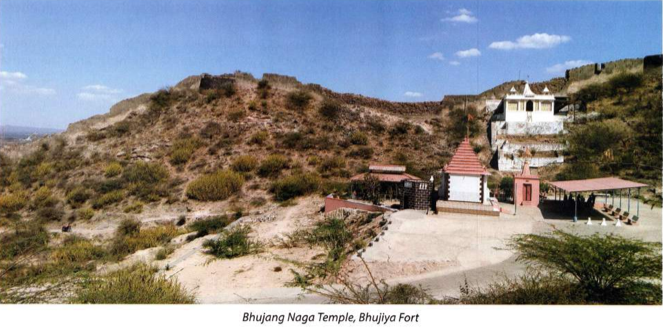
- Diu Fort: Built by the Portuguese in the 16th century, Diu Fort stands on the island of Diu. It is an excellent example of coastal defence architecture, featuring ramparts, bastions, and a lighthouse.
- Dabhoi Fort: Also known as Darbargadh, this fort is unique for its elaborate carvings and inscriptions. It was built during the Solanki period and remains an important cultural landmark.
- Ahmedabad Fort: Though largely in ruins, the remnants of Ahmedabad Fort, also known as Bhadra Fort, indicate its historical importance as the foundation of the city of Ahmedabad by Ahmed Shah I.
Architectural Features
- Gujarat’s forts are renowned for their robust construction, strategic locations, and intricate architectural details.
- Fortifications: High walls, bastions, and gates designed for defence against invaders are common features. Many forts have multiple layers of walls and ramparts.
- Religious Structures: Many forts include temples, mosques, and other religious buildings, reflecting the diverse cultural influences over time.
- Water Management Systems: Ingenious water management systems, including step wells (vavs), tanks, and reservoirs, are integral to these forts, ensuring water supply during sieges.
- Palaces and Residential Areas: These forts often include royal palaces, residential quarters, and audience halls, indicating their role as centres of administration and governance.
Cultural and Historical Significance
- The forts of Gujarat are not just military structures but also cultural and historical treasures.
- They offer insights into the architectural styles, engineering skills, and cultural practices of different periods.
- Many forts are associated with legends and folklore, adding to their mystique and tourist appeal.
Challenges in Preservation
- Many of these forts face challenges due to neglect, natural decay, and urban encroachment.
- The lack of adequate funding and resources for conservation efforts poses a significant threat to these historical sites.
- Tourism, while beneficial for raising awareness, also brings issues related to the preservation of these delicate structures.
Efforts in Conservation
- Government and non-governmental organisations are making efforts to preserve and restore these forts.
- Heritage walks, guided tours, and educational programs are being organised to raise awareness about the importance of these sites.
- Initiatives to involve local communities in preservation efforts are also being explored, recognizing their role in safeguarding these historical treasures.
Conclusion
- The forts of Gujarat are enduring symbols of the state’s rich historical and cultural heritage.
- Their preservation is crucial for understanding the region’s past and maintaining its legacy for future generations.
- Through combined efforts in conservation and awareness, these guardians of legacy and lore can continue to stand as testaments to Gujarat’s storied history
5. Forts In Delhi
Introduction
- The forts in Delhi are monumental structures that reflect the city’s rich history and strategic importance.
- These forts have been witnesses to the rise and fall of empires, serving as both defensive bastions and seats of power.
Historical Background
- Delhi’s forts date back to ancient times, with several being integral to the city’s development through various dynasties.
- They have been ruled by different empires, including the Rajputs, Delhi Sultanate, Mughal Empire, and the British.
- The architectural evolution of these forts mirrors the changing political and military strategies over the centuries.
Key Forts in Delhi
- Red Fort (Lal Qila): Built by Mughal Emperor Shah Jahan in the mid-17th century, the Red Fort is a symbol of Mughal opulence. It served as the main residence of Mughal emperors for nearly 200 years. The fort is renowned for its massive red sandstone walls, intricate marble inlays, and the iconic Lahori Gate.
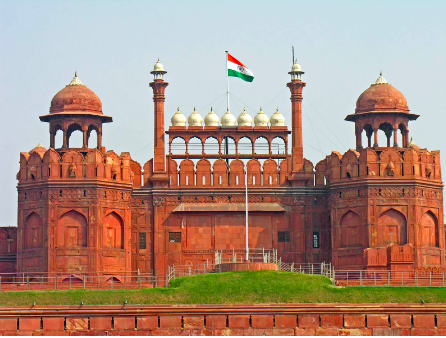
- Purana Qila (Old Fort): Purana Qila is one of the oldest forts in Delhi, with its history tracing back to the Mughal Emperor Humayun and Sher Shah Suri. The fort’s robust walls and three majestic gates showcase Mughal architecture. Inside the fort, the Qila-i-Kuhna Mosque and Sher Mandal are notable structures.
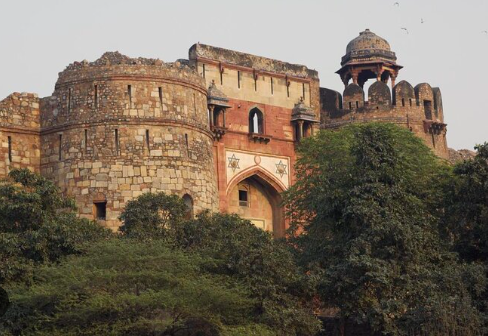
- Tughlaqabad Fort: Built by Ghiyas-ud-din Tughlaq in the early 14th century, this fort was intended to be a grand capital. The fort features massive stone walls, bastions, and an impressive layout that reflects the military engineering skills of the Tughlaq dynasty.
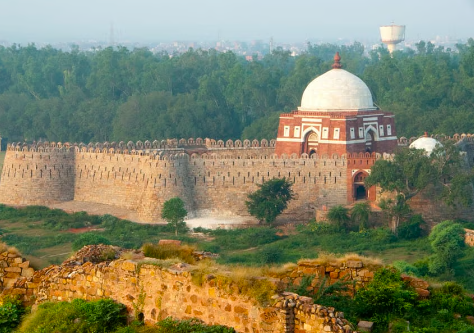
- Feroz Shah Kotla Fort: Constructed by Sultan Feroz Shah Tughlaq in the 14th century, this fort was part of the new city of Ferozabad. It houses the Ashokan Pillar, which was brought from Topra in Haryana. The fort’s ruins include palaces, mosques, and a unique stepwell.
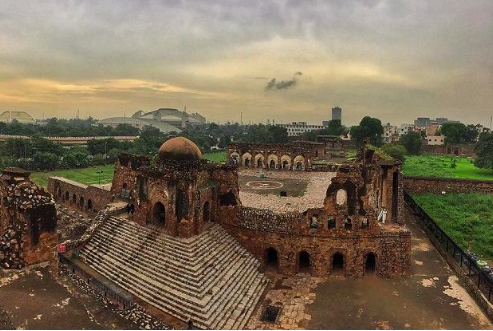
- Siri Fort: Built by Alauddin Khilji in the late 13th century, Siri Fort was the second city of Delhi. It was constructed to protect against Mongol invasions. Though largely in ruins, the remnants of Siri Fort give a glimpse into the fortifications of the Khilji dynasty.
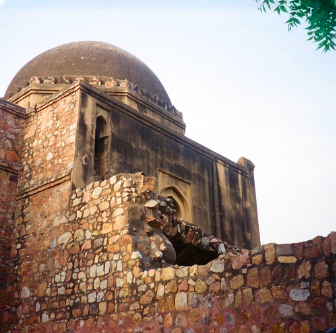
- Qila Rai Pithora: This fort was built by the Chauhan king Prithviraj Chauhan in the 12th century. It marks the establishment of Delhi as a significant city in the Rajput era. The fort’s walls and gates highlight the early defensive architecture of the region.
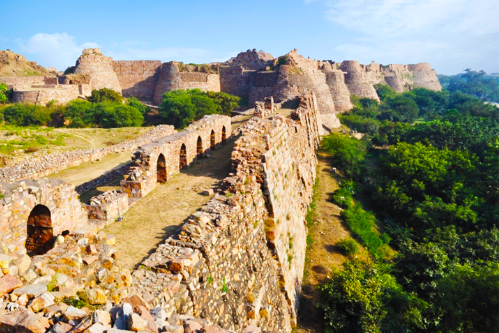
Architectural Features
- Delhi’s forts are celebrated for their robust construction, strategic designs, and intricate architectural details.
- Fortifications: High walls, bastions, and gates designed for defence against invaders are common features. Many forts have multiple layers of fortifications.
- Palaces and Halls: The forts include royal palaces, audience halls, and residential quarters that served as administrative and governance centres.
- Religious Structures: Many forts contain mosques, temples, and other religious buildings, reflecting the cultural and religious diversity of the times.
- Gardens and Water Systems: Ingenious water management systems, including canals, step wells, and gardens, are integral to these forts, demonstrating advanced engineering and aesthetics.
Cultural and Historical Significance
- The forts of Delhi are not just military structures but also cultural and historical landmarks.
- They offer insights into the architectural styles, engineering skills, and cultural practices of different periods.
- Many forts are associated with legends and historical events, adding to their mystique and tourist appeal.
Challenges in Preservation
- Many of these forts face challenges due to neglect, natural decay, and urban encroachment.
- The lack of adequate funding and resources for conservation efforts poses a significant threat to these historical sites.
- Tourism, while beneficial for raising awareness, also brings issues related to the preservation of these delicate structures.
Conclusion
- The forts of Delhi are enduring symbols of the city’s rich historical and cultural heritage.
- Their preservation is crucial for understanding the region’s past and maintaining its legacy for future generations.
- Through combined efforts in conservation and awareness, these guardians of legacy and lore can continue to stand as testaments to Delhi’s storied history.
6. Bekal Fort: A Fusion of culture and History echoing through time
Introduction
- Bekal Fort, located in Kerala, is a remarkable fusion of culture and history, reflecting the region’s strategic and cultural significance.
- This coastal fort stands as a testament to various historical periods, showcasing unique architectural and cultural elements.
Historical Background
- Bekal Fort’s origins trace back to the early mediaeval period, with significant contributions from different dynasties and rulers.
- The fort was initially constructed by the Kadampa dynasty in the 12th century and later expanded by the Kolathiri rulers.
- The most significant expansion occurred under the rule of Shivappa Nayaka of the Keladi Nayaka dynasty in the mid-17th century.
- The fort’s strategic location along the Malabar Coast made it a crucial defence point against invasions and a centre of maritime trade.

Architectural Features
- Bekal Fort is renowned for its unique blend of architectural styles and its strategic design.
- Massive Walls and Bastions: The fort features massive laterite stone walls and bastions, designed to withstand attacks and provide extensive views of the surrounding area.
- Observation Tower: A prominent observation tower offers a panoramic view of the Arabian Sea, illustrating the fort’s strategic importance for surveillance.
- Water Management Systems: The fort includes ingenious water management systems, such as a large tank with a tunnel, ensuring a steady water supply during sieges.
- Underground Passages: Bekal Fort has secret underground passages, highlighting its defensive architecture and the need for quick evacuation routes.
- Temple and Mosque: The fort houses both a Hanuman temple and a mosque, reflecting the cultural and religious diversity of the region.
Cultural Significance
- Bekal Fort is a symbol of cultural amalgamation, reflecting the influence of various rulers and communities over centuries.
- The presence of both Hindu and Muslim religious structures within the fort premises signifies the harmonious coexistence of different cultures.
- The fort’s design and construction techniques offer insights into the architectural innovations and cultural exchanges of the time.
- Bekal Fort has been a popular site for filmmakers, further embedding it in popular culture and attracting tourists.
Historical Events
- Bekal Fort has witnessed several historical events that shaped the region’s history.
- The fort played a crucial role during the Mysorean invasion led by Hyder Ali and his son Tipu Sultan in the late 18th century.
- Under British rule, the fort served as an important military station and administrative centre.
Challenges in Preservation
- Despite preservation efforts, Bekal Fort faces challenges due to natural decay, environmental factors, and the impact of tourism.
- Ensuring adequate funding and resources for ongoing maintenance is crucial for the fort’s preservation.
- Balancing tourism development with conservation efforts is essential to protect the fort’s historical integrity.
Significance
- Bekal Fort stands as a testament to the region’s rich history and cultural heritage.
- It offers valuable insights into the architectural, military, and cultural practices of different periods.
- The fort’s preservation is crucial for understanding Kerala’s historical legacy and promoting cultural tourism.
Conclusion
- Bekal Fort is a remarkable fusion of culture and history, echoing the region’s rich past and diverse influences.
- Its unique architectural features, cultural significance, and historical events make it an important heritage site.
- Preserving Bekal Fort is essential for maintaining the region’s historical and cultural legacy for future generations.
- Through continued efforts in conservation and tourism management, Bekal Fort can continue to inspire admiration and study, reflecting the enduring legacy of Kerala’s historical richness.
7. Vellore Fort: The Great Garrison of South India
Introduction
- Vellore Fort, often referred to as “the iron throne of South India,” is a significant historical and architectural landmark in Vellore, Tamil Nadu.
- This fort has served as a seat of power for various dynasties, including the Pallavas, Cholas, Marathas, Bijapur Sultans, and Arcot Nawabs.
- It stands as a testament to the region’s rich history and strategic importance.
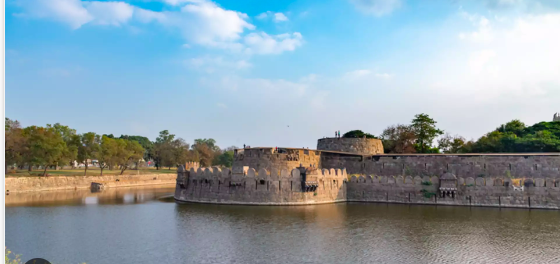
History
Early History and Construction
- Vellore Fort was built in 1556 AD by Chinna Bommi Nayak and Timma Nayak under the Vijayanagar Empire.
- It served as a stronghold and headquarters, becoming a pivotal centre during the Vijayanagar rule.
- The fort saw strategic importance during battles like the Battle of Toppur.
Under Various Dynasties
- Aravidu Dynasty: The fort was used as a military base during conflicts with the Bijapur Sultanate.
- Marathas: Captured the fort in 1678 AD after a prolonged siege, showcasing its strategic importance.
- Mughals: In 1707 AD, Daud Khan captured the fort after Aurangzeb’s death, marking a shift in control.
- British East India Company: Vellore Fort became a major garrison from 1799 until Indian Independence in 1947.
Vellore Mutiny (1806)
- The fort was the site of the first significant mutiny by Indian soldiers against the British.
- The mutiny occurred due to discontent over new regulations and turbans imposed by General Agnew.
- This brief but violent uprising within the fort was swiftly suppressed by the British.
Architectural Significance
- Vellore Fort is a classic example of mediaeval architecture in South India, primarily built of granite.
- The fort’s design and construction reflect the architectural prowess of the Vijayanagar Empire and subsequent rulers.
- Structures Inside the Fort
- Jalakanteswara Temple: Built by the Vijayanagar Empire, the temple is renowned for its intricate sculptures and detailed carvings.
- Mahals: The fort houses several palaces, including Tipu Mahal, Begam Mahal, and Khandi Mahal, each showcasing lavish interiors and royal architecture.
- St John’s Church and Mosque: These structures reflect the religious diversity and architectural styles of different periods within the fort.
- Archaeological Museum: The museum inside the fort houses a diverse collection of artefacts spanning from ancient to modern times, offering a glimpse into the region’s rich history.
Tourist Attractions
- Vellore Fort is a major tourist attraction due to its historical significance and architectural beauty.
- Local Attractions
- Sripuram Golden Temple: A stunning temple complex known for its gold-coated structure, attracting numerous visitors.
- Muthu Mandapam: A memorial built on the banks of Palar River, dedicated to Sri Vikrama Rajasinha, the last ruler of Sri Lanka.
- Amirithi Zoological Park: A small zoo located in the foothills of the Eastern Ghats, ideal for nature enthusiasts.
- Armamalai Cave Paintings: Ancient cave paintings located near Vellore, showcasing the region’s prehistoric art.
- Location and Accessibility
- Vellore Fort is centrally located in Vellore city, making it easily accessible via road, rail, and air.
- The fort’s strategic location has historically made it an important site and continues to attract tourists from all over the country.
Conclusion
- Vellore Fort stands as a testament to the rich history and architectural heritage of South India.
- From its origins under the Vijayanagar Empire to its role in colonial conflicts, the fort has witnessed centuries of political upheaval and cultural evolution.
- Today, it serves as a major tourist attraction and a reminder of India’s historical resilience and architectural prowess.
- Preserving this fort is crucial for maintaining the historical and cultural legacy of the region, ensuring that future generations can appreciate its significance.
8. Medieval Ports and Forts
Introduction
- Maharashtra’s coastal geography has been pivotal in its historical development, especially during the mediaeval period.
- The Sahyadri mountain range gives rise to numerous rivers flowing into the Arabian Sea, forming creeks along the coast.
- These geographical features facilitated the construction of various forts, particularly at the mouths of these creeks, to protect trade and commerce.
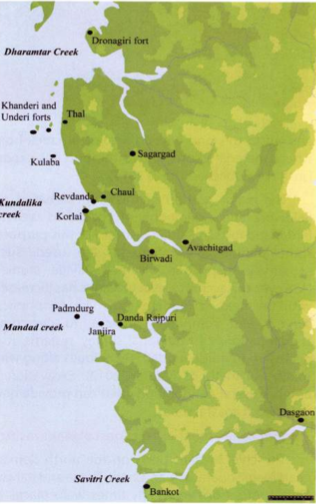
Coastal Forts
- The coastal region of Maharashtra is characterised by bays with narrow inlets or creeks, coastal plains, and headlands.
- Numerous forts were constructed at strategic points to guard against invasions and to control trade routes.
- Examples include Revdanda and Korlai Forts on Kundalika Creek.
- Janjira Fort near Danda Rajapuri Creek is another notable example.
- Out of twenty-eight major creeks in Maharashtra, twenty-one have forts at their mouths as well as further upstream, highlighting their strategic importance.
Inland (Hinterland) Forts
- Forts situated more than two kilometres from the coast are known as inland or hinterland forts.
- These forts played a crucial role in securing the hinterland and ensuring the safe passage of goods to and from the ports.
- Notable inland forts include Birwadi Fort and Avchitgad Fort.
- These forts were integral in maintaining control over trade routes and protecting the economic interests of the region.
Ports and Trade
- Maharashtra’s ports were hubs of trade, interacting with various regions and countries.
- Significant ports included Sopara, Sanjan, Chaul, Thana, and Kalyan.
- These ports facilitated extensive trade with the West and were mentioned in historical records and travel accounts from various periods.
- The ports were critical in the flow of goods, contributing to the economic prosperity of mediaeval Maharashtra.
Strategic Importance and Fort Construction
- The fortifications in Maharashtra were often strategically placed to protect trading activities and maritime routes.
- Key points include Kundalika Creek with Chaul and Revdanda Forts, and Mandad Creek with Janjira Fort.
- Excavations at these sites have revealed significant historical and archaeological data, confirming their importance in maritime trade.
- The strategic placement of these forts ensured the protection of vital trade routes from foreign invasions and internal conflicts.
Decline of Ports
- The rise of Mumbai as a major port led to the decline of smaller ports like Chaul and Dabhol.
- Siltation of rivers also contributed to the reduced navigability of these ports, further diminishing their significance.
- As Mumbai grew in prominence, the focus of maritime trade shifted, leading to the gradual decline of these once-thriving ports.
Significance
- The forts and ports of mediaeval Maharashtra were instrumental in shaping the region’s trade and defence mechanisms.
- They facilitated the flow of goods and people, contributing to economic and cultural exchanges between India and other parts of the world.
- The strategic construction of forts ensured the protection of these vital trade routes, safeguarding the region’s economic interests.
- These structures also played a crucial role in the region’s military history, providing defence against invasions and maintaining internal security.
Conclusion
- The mediaeval ports and forts of Maharashtra are a testament to the region’s rich history and strategic importance in maritime trade.
- These structures served not only military purposes but also played a crucial role in the economic prosperity of the region.
- Understanding their history and significance provides valuable insights into the historical development of trade and defence mechanisms in coastal Maharashtra.
- The preservation and study of these forts and ports are essential for appreciating the historical and cultural heritage of Maharashtra.
9. India on the UNESCO World Heritage List
Introduction
- India boasts a rich cultural and historical heritage, reflected in its extensive list of UNESCO World Heritage Sites.
- The UNESCO World Heritage list includes sites of outstanding universal value, and India’s inclusion highlights its global significance in culture, architecture, and natural beauty.
- This summary provides an overview of India’s UNESCO World Heritage Sites, detailing their significance, features, and historical context.
Cultural and Historical Monuments
- Agra Fort
- The Agra Fort, also known as the Red Fort of Agra, is a prominent Mughal monument constructed in the 16th century.
- It includes notable structures like the Jahangir Palace and the Khas Mahal, which were built by Emperor Shah Jahan.
- The fort served as a major Mughal stronghold and administrative center.
- Ajanta Caves
- The Ajanta Caves consist of 29 rock-cut caves located in Maharashtra.
- These caves are renowned for their ancient Buddhist murals and sculptures, depicting the life of Buddha and various Jataka tales.
- They represent a key phase in Buddhist art and architecture.
- Archaeological Site of Nalanda Mahavihara at Nalanda
- Nalanda is recognized as one of the oldest universities in the world.
- The site includes archaeological remains of a monastic and scholastic institution dating from the 3rd century BCE to the 13th century CE.
- It was a major center of learning and intellectual exchange in ancient India.
- Buddhist Monuments at Sanchi
- The Buddhist Monuments at Sanchi include monolithic pillars, palaces, temples, and monasteries.
- Sanchi is considered one of the oldest Buddhist sanctuaries still in existence.
- The site is known for its stupa, which is a significant example of early Buddhist architecture.
- Champaner-Pavagadh Archaeological Park
- This park includes a range of unexcavated archaeological, historic, and cultural heritage properties.
- Structures from the 8th to 14th centuries are found here, including fortifications, palaces, religious buildings, and water installations.
- It reflects the historical and architectural developments of the region.
- Chhatrapati Shivaji Terminus
- Originally named Victoria Terminus, this railway station in Mumbai is an example of Victorian Gothic Revival architecture in India.
- Designed by British architect F. W. Stevens, it symbolizes the colonial era’s architectural style and significance.
- Churches and Convents of Goa
- The Churches and Convents of Goa, situated in the former Portuguese capital, signify the evangelization of Asia.
- The site includes significant churches and convents that showcase Portuguese colonial architecture and religious influence.
- Elephanta Caves
- Known locally as Gharapuri Caves, the Elephanta Caves are located on an island near Mumbai.
- There are seven caves featuring Hindu rock-cut temples, with intricate carvings dedicated to Shiva, including the famous Trimurti.
- Ellora Caves
- The Ellora Caves include 34 monasteries and temples carved into the rock.
- These caves feature Buddhist, Hindu, and Jain temples, reflecting a range of religious and architectural styles from 600 to 1000 CE.
- The Kailasa Temple is a notable example of monolithic rock-cut architecture.
- Fatehpur Sikri
- Built by Mughal Emperor Akbar, Fatehpur Sikri served as the Mughal capital for a decade.
- The complex includes various significant structures such as the Jama Masjid and the Buland Darwaza.
- It represents Mughal architectural brilliance and urban planning.
- Great Living Chola Temples
- This site includes three major temples: the Brihadeesvara Temple at Thanjavur, the Brihadisvara Temple at Gangaikondacholisvaram, and the Airavatesvara Temple at Darasuram.
- These temples exemplify Chola dynasty architecture with grand structures, detailed sculptures, and inscriptions.
- Group of Monuments at Hampi
- Hampi, once the capital of the Vijayanagara Empire, features an extensive collection of ruins.
- The site includes temples, palaces, and market areas, with notable structures like the Virupaksha Temple and the Stone Chariot.
- Hampi reflects the grandeur and architectural innovations of the Vijayanagara Empire.
- Group of Monuments at Mahabalipuram
- Mahabalipuram is renowned for its group of rock-cut temples and monuments.
- Highlights include the Rathas, Mandapas, and giant open-air reliefs like the Descent of the Ganges.
- The site showcases Dravidian architecture and artistic achievements of the Pallava dynasty.
- Group of Monuments at Pattadakal
- Pattadakal features a collection of Hindu and Jain temples known for their Chalukyan art.
- The temples, built between the 7th and 8th centuries, display a mix of architectural styles and intricate carvings.
- The site is significant for understanding the evolution of temple architecture in South India.
- Hill Forts of Rajasthan
- This site includes several hill forts such as Chittorgarh, Kumbhalgarh, Sawai Madhopur, Jhalawar, Jaipur, and Jaisalmer.
- These forts, built between the 7th and 19th centuries, reflect Rajput military architecture and strategic planning.
- They served as defensive structures and centers of regional power.
- Historic City of Ahmedabad
- Founded by Sultan Ahmad Shah in the 15th century, Ahmedabad features a well-preserved walled city.
- The city’s architecture reflects a blend of Hindu, Muslim, and Jain influences, showcasing its historical significance and cultural diversity.
- Humayun’s Tomb
- Built in 1570, Humayun’s Tomb is the first garden tomb in the Indian subcontinent.
- The tomb, constructed by Emperor Humayun’s widow, is an important example of Mughal garden tombs and inspired the Taj Mahal.
- Jaipur City
- Founded by Sawai Jai Singh II in 1727, Jaipur is known for its planned city layout and architectural heritage.
- The city includes notable structures such as the Hawa Mahal and City Palace, reflecting Rajput architecture and urban design.
- Khajuraho Group of Monuments
- The Khajuraho temples, built by the Chandela dynasty, are famous for their intricate and erotic sculptures.
- The group includes temples dedicated to Hinduism and Jainism, showcasing a high level of artistic skill and religious devotion.
- Mahabodhi Temple Complex
- The Mahabodhi Temple in Bodh Gaya is one of the four holy sites related to the Buddha’s life.
- The temple is a significant pilgrimage site and an important example of early Buddhist architecture.
- Mountain Railways of India
- This site includes three historic railways: the Darjeeling Himalayan Railway, Nilgiri Mountain Railway, and Kalka-Shimla Railway.
- The railways, built during the British colonial period, are noted for their scenic routes and engineering achievements.
- Qutb Minar and its Monuments
- The Qutb Minar in Delhi is the highest tower in India, built in the 13th century.
- The site includes the Qutb Minar, Quwwat-ul-Islam Mosque, and the Iron Pillar, reflecting early Indo-Islamic architecture and engineering.
- Rani-ki-Vav (the Queen’s Stepwell)
- Rani-ki-Vav, located in Patan, Gujarat, is a stepwell built in the Maru-Gurjara architectural style.
- It features intricate carvings and served as a water reservoir and place of worship.
- Red Fort Complex
- The Red Fort Complex, also known as Lal Qila, was built as the palace fort of Shah Jahan’s capital, Shah Jahanabad.
- It includes the Salimgarh Fort and represents Mughal architectural and urban planning achievements.
- Rock Shelters of Bhimbetka
- Discovered by Dr. V. S. Wakankar in 1958, the Bhimbetka Caves are known for their prehistoric rock paintings.
- The site provides insights into early human life and art.
- Sun Temple
- The Sun Temple in Konark, built by King Narasimhadeva I in the 13th century, represents Kalinga architecture.
- The temple is renowned for its chariot-shaped structure and intricate stone carvings.
- Taj Mahal
- The Taj Mahal, built by Mughal Emperor Shah Jahan, is a mausoleum located on the banks of the Yamuna River.
- It is an architectural masterpiece and a symbol of Mughal grandeur and enduring love.
- The Architectural Work of Le Corbusier
- This site includes 17 locations on three continents, with Complexe du Capitole in Chandigarh, India, being one of them.
- It reflects Le Corbusier’s significant contributions to modern architecture and urban planning.
- The Jantar Mantar
- The Jantar Mantar in Jaipur, built by Rajput king Sawai Jai Singh II, is an astronomical observatory.
- It includes large-scale instruments for measuring celestial bodies and time, showcasing advanced knowledge of astronomy.
- Victorian Gothic and Art Deco Ensembles of Mumbai
- This site includes Victorian Neo-Gothic public buildings and Art Deco structures in Mumbai.
- The buildings represent a fusion of architectural styles from the colonial period and early 20th century.
- Great Himalayan National Park-Conservation Area
- Located in Himachal Pradesh, the park features high alpine peaks, meadows, and riverine forests.
- It is known for its biodiversity and conservation efforts, protecting various species of flora and fauna.
- Kaziranga National Park
- Situated in Assam’s Karbi Anglong district, Kaziranga National Park is renowned for its population of one-horned rhinoceroses.
- It is a crucial site for wildlife conservation and a UNESCO World Heritage Site.
- Keoladeo National Park
- Formerly known as Bharatpur Bird Sanctuary, this park is a wintering area for migratory birds, including the Siberian Crane.
- It is a significant bird sanctuary and conservation area.
- Manas Wildlife Sanctuary
- Manas Wildlife Sanctuary, a biosphere reserve and tiger reserve, was the first reserve included in Project Tiger in 1973.
- It features diverse ecosystems and is crucial for the conservation of several endangered species.
- Nanda Devi and Valley of Flowers National Parks
- Nanda Devi West is the second-highest mountain in India, and the Valley of Flowers is known for its diverse alpine flora.
- The parks are significant for their natural beauty and biodiversity.
- Sundarbans National Park
- Located in the Gangetic Delta, Sundarbans National Park is known for its mangrove forests and Bengal tigers.
- It is a crucial area for the conservation of endangered species and ecological research.
- Western Ghats
- The Western Ghats are a biodiversity hotspot, known for their rich flora and fauna.
- The mountain range stretches across several states and is crucial for ecological balance and conservation.
- Khangchendzonga National Park
- Khangchendzonga National Park, featuring Mount Khangchendzonga (the world’s third-highest peak), is located in Sikkim.
- It is known for its unique landscapes and biodiversity.
- Kakatiya Rudreshwara (Ramappa) Temple
- Built in the 13th century CE, this temple is a Kakatiyan architectural marvel made of sandstone and features a pyramidal Vimana made of ‘floating bricks’.
- The temple is renowned for its detailed carvings and innovative construction techniques.
- Dholavira
- Discovered by Jagat Pati Joshi in 1968, Dholavira was an ancient commercial and manufacturing hub.
- It was one of the Indus Valley Civilization’s major cities, reflecting advanced urban planning and trade practices.
- Santiniketan
- Founded by Rabindranath Tagore in 1901, Santiniketan is the site of Visva-Bharati University and is known for its architectural and educational significance.
- The efforts to list Santiniketan as a UNESCO World Heritage Site highlight its cultural and historical importance.
- Sacred Ensembles of the Hoysalas
- The Sacred Ensembles of the Hoysalas include temples in Belur, Halebidu, and Somanathapura, Karnataka.
- The temples are celebrated for their intricate carvings and architectural style, representing the Hoysala dynasty’s artistic achievements.
